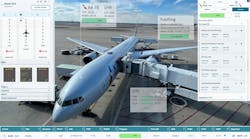It’s encouraging to see the nation's travel sector bouncing back swiftly from the pandemic.
We’re not out of the woods yet, but things are looking up. And for the industry, within days of the CDC issuing guidance that vaccinated Americans no longer have to wear a mask, the sense of normal got closer and people started booking airfare in a frenzy.
Hawaiian Airlines saw its website bog down from too many people booking travel. Swaths of people started appearing back in our major airports. Things are looking up.
But it’s more important the industry looks forward, not up. The runway to recovery is absolutely littered with the FOD of failures that can make quick work of this optimism.
The Colonial Pipeline is one hard slap of reality I’m talking about. One hacking attempt set off a fuel shortage across the eastern U.S. that gravely endangered the jet fuel supply for airports. This on top of continual cyber attacks on our airports, which have caused massive security issues.
The Biden Administration’s American Jobs Plan includes funding for cybersecurity efforts on top of the $1 billion authorized earlier in the year to modernize the federal government’s cybersecurity infrastructure.
Most people in the industry are focused on the $25 billion to help fund the Airport Improvement Program being proposed for the plan. But an ACI-World survey from earlier this year showed more than 60 percent of airport respondents confirmed their airports were targeted by cyberattacks.
Airport leaders need to make cybersecurity one of their top priorities before things get worse. I know your budgets are bare thanks to COVID, but building a comprehensive effort to protect your facilities has to be put front and center.
Zhen Xu, IT director for Avfuel suggested in a recent article on our website that airports and FBOs work with their IT departments or a solution provider to identify and mitigate security threats. Any improvement that’s implemented requires upkeep and maintenance to safeguard against evolving threats.
This isn’t as easy as buying software and hoping you’re good for a couple of years. This takes annual attention and includes training your staff to spot issues.
The pandemic made travel more touchless and technology-dependent than ever before. This is the new future but it doesn’t do the industry any good if we have these tools that just expose facilities and travelers to new risks.



